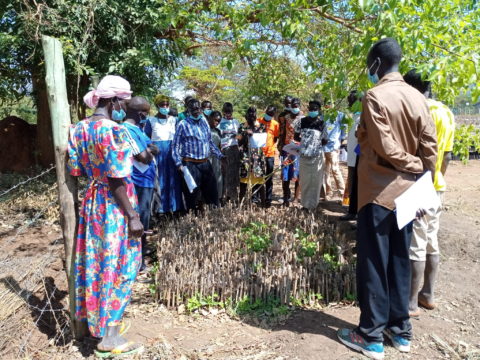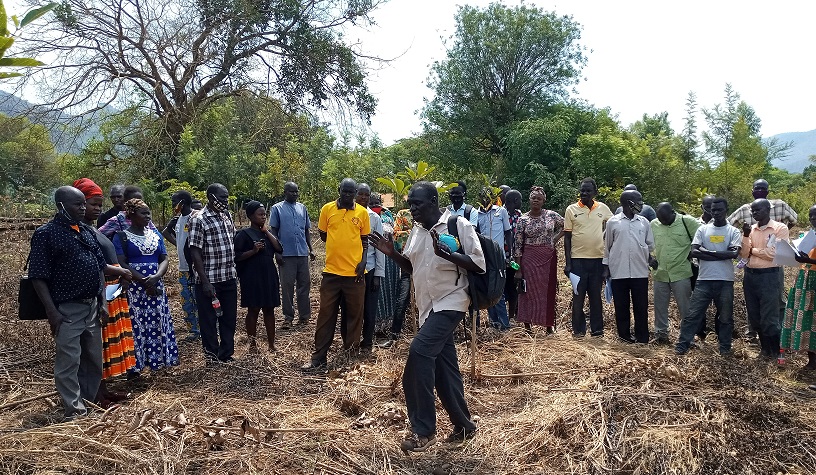Simon Peter Bua, a smallholder farmer aged 39, doubles up as an adult-learning teacher for his community in Angaro micro-catchment, North West Uganda. With seven mouths to feed, he supplements his meagre income by making and selling bricks for house construction. In 2012, he secured a loan of USD 1300 from his village savings and loan association to buy six acres of land adjacent to a forest reserve to practice diversified farming.
Last June, Bua was one of 90 tree farmers supported by Wetlands International and the National Forestry Authority (NFA) to establish small-scale farm forestry enterprises. To diversify his livelihood options, he dedicated three acres for trees and received some 1,100 seedlings of indigenous and naturalised fast-growing trees ideal for agroforestry. He practices Taungya system, a form of agro-forestry that includes food crops and fruits such beans, cassava, soya beans, mangoes and paw paws. By weeding the food crop, this system reduces operational and maintenance costs of weeding the tree farm.

Simon Peter Bua weeding his Grevillea robusta trees
This agroforestry initiative aimed to plant and maintain 100 hectares with 92,926 assorted tree seedlings within three micro catchments in the area that form part of the numerous wetlands draining into the River Nile system.
Subsequently, a joint project monitoring effort was undertaken after six months and which registered 60-70 per cent survival rate; a fairly good performance notwithstanding the challenges of drought, termites and stray domestic livestock. The best performing tree species were Bathdevia, Grevillea, Arborea, Markhamia, tamarind, guava, jackfruit, pines and eucalyptus. Seventeen outstanding farmers including Bua were identified and are targeted for additional assistance in this year’s tree planting programme.
In a bid to increase tree coverage in the region, 74 farmers will be supported in the next expected rainy season between April and June. They comprise the outstanding farmers from the past year and new recruits including those specialising in bamboo. Some two dozen farmers have been recruited to domesticate bamboo in the area neighbouring the Central Forest Reserves where illegal and unsustainable harvesting of natural bamboo by the local community is rife. These farmers were recently trained on the basics of seedlings production, field establishment and maintenance, bamboo propagation, domestication and planting. In addition, they were trained on basics of forest and nursery management.

Bamboo farmers were trained on sourcing for planting materials, propagation and multiplication in the tree nursery site, on-farm planting and domestication.
An estimated 5,000 bamboo seedlings will be planted in 10 hectares while the other farmers will cover 46 hectares with 46,000 assorted tree species. All farmers – including those who recorded low success rates due to rife challenges – will get support from the NFA to enhance the project’s sustainability and consolidate progress.
On account of demonstrating good tree survival rate and good forest management practices, Bua will be provided tree seedlings to help him establish an additional four acres with trees.
“I have a burning tree growing passion and plan to establish a commercial tree nursery in my farm. This will act as my source for tree seedlings and, hopefully, once I expand my farm in the near future, I can sell seedlings to others keen on agroforestry,” states Bua.
Some of the recommendations from the joint monitoring were that: a comprehensive, actionable and costed Forest Landscape Plan for 2021 will be prepared and presented; and that fruit trees remain should be considered a vital component of restoration in a fragile ecosystem like Karamoja to support community livelihoods and improve their resilience against environmental hazards. Also, the Karamoja Forestry Range of NFA is committed to the cause of forest landscape restoration and will provide the tree and bamboo seedlings required and the roles and participation of the wetlands committees in the project’s sustainability should be enhanced.

Best performing farmers provided with watering cans and termicide for pest control
The ecosystem restoration initiative is part of the three-year Ecosystem-based Disaster Risk Reduction (Eco-DRR) project that uses an Integrated Risk Management (IRM) approach. It involves ecosystem management and restoration such as development of management plans, climate change adaptation and mitigation, and disaster risk reduction while mainstreaming gender in all its activities. Awarded by the European Commission to the UN Environment Programme (UNEP) in collaboration with Partners for Resilience (PfR) represented by the Netherlands Red Cross (NLRC), it focuses on scaling-up Eco-DRR interventions.
Lead photo: NFA’s Karamoja Forestry Range Manager Michael Okot takes farmers through a field-based practical training session on Farmer Managed Natural Regeneration (FMNR) at Akur Central Forest Reserve
